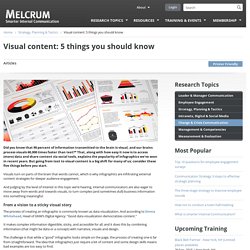

Visual content: 5 things you should know. Did you know that 90 percent of information transmitted to the brain is visual, and our brains process visuals 60,000 times faster than text?

* That, along with how easy it now is to access (more) data and share content via social tools, explains the popularity of infographics we’ve seen in recent years. But going from text to visual content is a big shift for many of us; consider these five things before you start. Visuals turn on parts of the brain that words cannot, which is why infographics are infiltrating external content strategies for deeper audience engagement.
And judging by the level of interest in this topic we’re hearing, internal communicators are also eager to move away from words and towards visuals, to turn complex (and sometimes dull) business information into something meaningful. From a vision to a sticky visual story The process of creating an infographic is commonly known as data visualization. 1. No good infographic is ever created by just one person. 2. Journalism in the Age of Data: A Video Report on Data Visualization by Geoff McGhee. 10 Steps To Designing An Amazing Infographic. Information can be useful—and even beautiful—but only when it’s presented well.

In an age of information overload, any guidance through the clutter comes as a welcome relief. That’s one reason for the recent popularity of information graphics. Infographics are visual designs that help to explain complicated data in a simple way (mental-health emergencies at Burning Man, anyone?). But how are they created? What can we learn from the designer’s process? Over the last decade, Hyperakt has come to specialize in this type of design, and we’ve found a process that works for us. 1. Sifting through data is where it all begins. 2.
While it’s tempting to read only the highlighted facts and skim the rest, this shortcut tends to result in more time wasted later. 3. What starts as boring data will become a boring infographic unless a great story can be found. 4. As a story emerges from the data at hand, it’s time to stop for a reality check. The truth in information takes experience to uncover. People Don’t Like To Read. Stop Upset Them With Text! [Introducing the tl;dr section] Gordon Gower wrote me already a month ago asking me how I planned to celebrate my first blog anniversary coming up in the end of July. To be honest, until now I had no idea. Yesterday, the much-desired update from my internal comms hero, Ian Harris , head of content at Gatehouse and author of the book Rock Your Comms – 98 Tips from Internal Communication Pros (read more about my admiration for him here ), arrived in my inbox. As Ian always writes the most entertaining and eloquent, yet highly informative, articles on internal communication, I wasn’t surprised but still excited over his latest post .
Campaign for brevity Ian introduced the abbreviation tl;dr to me, which is an expression meaning “too long, didn’t read”. For clarity I’ll better quote him: “ For years, people on online forums have replied ‘tl;dr’ to insult people who write lengthy posts. Internal communication no longer than a tweet Turning text into a picture The tl;dr is the ultimate answer to this viewpoint. About the author.